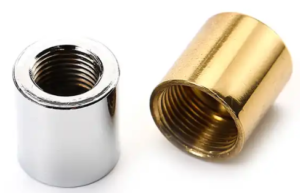What is tapping manufacturing process
Tapping is the process of creating threads in a hole by using a tap. Tapping is an important process for producing threaded components such as nuts, bolts and screws. In this article, we will discuss the tapping manufacturing process, its applications, advantages and disadvantages.

Tapping process
The tapping process involves using a tool called a tap to create internal threads in a hole. A tap is a cutting tool with a series of ridges or teeth designed to cut into material while rotating. The tap is inserted into the hole and cuts into the material as it turns, forming threads. There are two main types of taps: hand taps and machine taps. Hand taps are used with a tap wrench and are typically used for smaller diameter holes, while machine taps are used with machines such as drill presses or lathes for larger diameter holes.
The tapping process can be done manually or with the help of a tapping machine. In manual tapping, a tap wrench is used to turn the tap by hand. This method is suitable for small-scale production or tapping holes in difficult-to-machine materials. In machine tapping, the tap is mounted on a machine such as a drill press or lathe, and the machine controls the speed and feed of the tap. This method is more efficient and is often used in mass production.

Tapping application
The tapping process is widely used in industries that create threads in holes. Some common applications of tapping include:
– Manufacturing of nuts, bolts and screws: Tapping is an important process in the production of fasteners such as nuts, bolts and screws. These components are used in a variety of applications including automotive, aerospace and construction.
– Processing of metal and plastic parts: Tapping is used to produce metal and plastic parts that require threads, such as housings, brackets and fittings.
– Repair and Maintenance: Tapping is also used in repair and maintenance operations to create threads in damaged holes or to replace damaged fasteners.
Advantages of tapping
There are several advantages to using the tapping process in manufacturing:
– Cost-effective: Compared to other methods such as thread milling or thread rolling, tapping is a cost-effective method of producing threads in holes.
– Versatility: Tapping can be used on a variety of materials, including metals, plastics and composites.
– Fast: Tapping is a relatively quick process, especially when done using a tapping machine, making it suitable for mass production.
– Accuracy: Tapping produces accurate and high-quality threads, making it the preferred method for creating threaded components.
Disadvantages of tapping
Despite its advantages, there are some disadvantages to using the tapping process:
– Tool wear: Taps wear out quickly, especially when tapping hard materials or when used at high speeds.
– Chip evacuation: Chips generated during tapping can accumulate in the hole, causing clogging and poor thread quality.
– Limited thread depth: Tapping is limited in the maximum thread depth achievable, which can be a disadvantage in some applications.
In summary, tapping is a widely used manufacturing process for creating threads in holes. It is a cost-effective, versatile and fast method that can be used in a variety of industries. While tapping has its advantages, such as accuracy and speed, it also has its disadvantages, such as tool wear and limited thread depth. Overall, tapping is an important process in the production of threaded components and remains an important manufacturing method.

Leave a Reply
Want to join the discussion?Feel free to contribute!